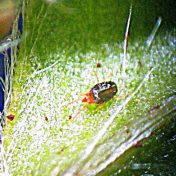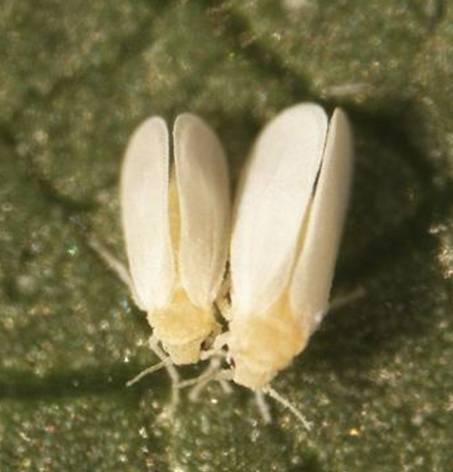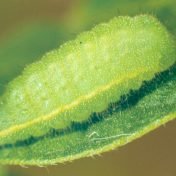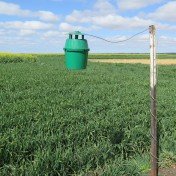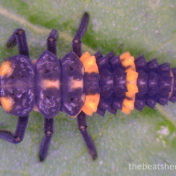Significant soybean aphid (Aphis glycines) populations have now been observed in many coastal soybean crops. Once the crop approaches late flowering, a spray decision must be made as later aphid infestations can severely delay harvest maturity. Careful monitoring is required to determine if populations are trending upwards to and beyond threshold levels, or if the aphids are being contained by… Read more »
Peanut mite (Paraplonobia sp.) outbreaks have been widely reported in Burnett peanut crops from Kingaroy to Coulston Lakes. This is not surprising as these mites are favoured by prolonged hot dry weather as has been experienced lately. The first sign that these mites are present are plants with pale leaves. On closer inspection, fine feeding stipples are evident on the… Read more »
With cotton crops approaching cut-out, it’s time to make critical decisions regarding silverleaf whitefly (SLW) management. Recent hot weather has seen SLW numbers increase in many areas—indicating that a number of fields are likely to require control action soon. SLW has evolved to become one of the most complex insects to manage in a cotton system because we are essentially controlling… Read more »
Notes from the meeting at DAF, Monday 21 January 2019 The South Australian Research Institute (SARDI) leads the major GRDC investment in Russian Wheat Aphid (RWA) research in southern Australia. Dr Maarten van Helden and Tom Heddle (SARDI) were in the northern grains region conducting a survey of RWA in the ‘green bridge’ (roadside grasses) during January 2019 (GRDC project… Read more »
A major outbreak of grass blue butterfly (GBB) (Zizina labradus) in late vegetative and flowering soybeans has been reported in the Maryborough/Hervey Bay region. Some crops inspected had 10-12 GBB larvae per square metre with many plants denuded of buds and flowers. Other crops had less damage and fewer larvae (4-5 per square metre), but had 5 or more adult butterflies… Read more »
A common misconception is that, like humans, pests become more lethargic in hot weather. Unfortunately, the opposite is true—in most cases warmer weather actually speeds up pest growth with pests reaching a damaging size and pest populations increasing more quickly. Also, hot weather is often associated with little or no rain. And rain, particularly heavy rain, can suppress aphid, mite… Read more »
Monday 21 January at 8 am Green Room, QDAF Conference Centre, 203 Tor St, Toowoomba. In October 2018, detections of Russian wheat aphid (RWA) were made in Cowra, Forbes, and Condobolin on the Liverpool Plains, and Coonabarabran. NSW DPI Biosecurity reported these detections (read the document here). The map below shows the location of RWA detections in NSW. No detections have… Read more »
The 2018 spring Helicoverpa pheromone trapping program for the Northern Grains Region has recently concluded. The program, run by the Queensland Department of Agriculture and Fisheries for the Northern Grain Growing region, forms part of the national Helicoverpa monitoring network jointly run by DAF, cesar, SARDI, and DAFWA. The primary purpose of the trapping network is to detect high moth… Read more »
While agrochemicals are an important component of many pest management programs, care must be taken to ensure that any spray operations use registered products that are applied according to the product label. The manager of an Emerald farm has recently been fined $10,000, pleading guilty to a breach of the Chemical Usage (Agriculture &Veterinary) Control Act 1988 after significant levels… Read more »
Adult ladybird beetles are one of the most easily recognisable natural enemies in cropping systems. Both adults and larvae are voracious predators, and can have a considerable impact on pest populations, particularly aphids. Several species of ladybird beetles are commonly encountered each year in grain, pulse and cotton crops. Ladybirds are often attracted into crops by the presence of aphids,… Read more »


